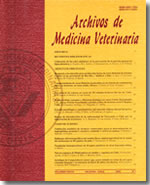A note on the effects of pre-slaughter operations of llamas (Lama glama) on the concentrations of some blood constituents related to stress and carcass quality
Main Article Content
Abstract
The objective of the current study was to assess the effects of pre-slaughter operations in llamas on physiological (concentrations of some blood constituents) and carcass quality (pH and bruises) indicators under commercial conditions. Thirty llamas raised on pasture, 18-24 months old and average live weight of 54.2±6.4 kg were transported on a single 3 h journey in one batch to the slaughterhouse. Blood samples were taken on farm one hour before loading, after unloading, after lairage (18 h) and during exsanguination to measure the concentrations of various stress-related variables. Mean values for the blood variables showed a significant rise (P < 0.05) in the concentration of cortisol immediately after transport (16.9 ng/mL), as well as CK activity after lairage (528.4 UI/L); β-hydroxybutyrate concentration showed similar mean values for the different sampling times. A total of 19 bruises were found on 9 of the carcasses. The backs (loin) of carcasses had more bruises (57.89%), followed by thorax (21.05%). Irregularly shaped bruises were the most frequent (81.25%), followed by circular bruises (18.75%). It was concluded that pre-slaughter handling of llamas under these commercial conditions produced physiological changes similar to those in other species, which fall within acceptable limits for their welfare; however stress could be reduced and adverse effects like bruises could be minimized by designing proper facilities, by following OIE recommendations on the welfare of animals during stunning and by training of personnel handling llamas all along the Bolivian meat chain.

